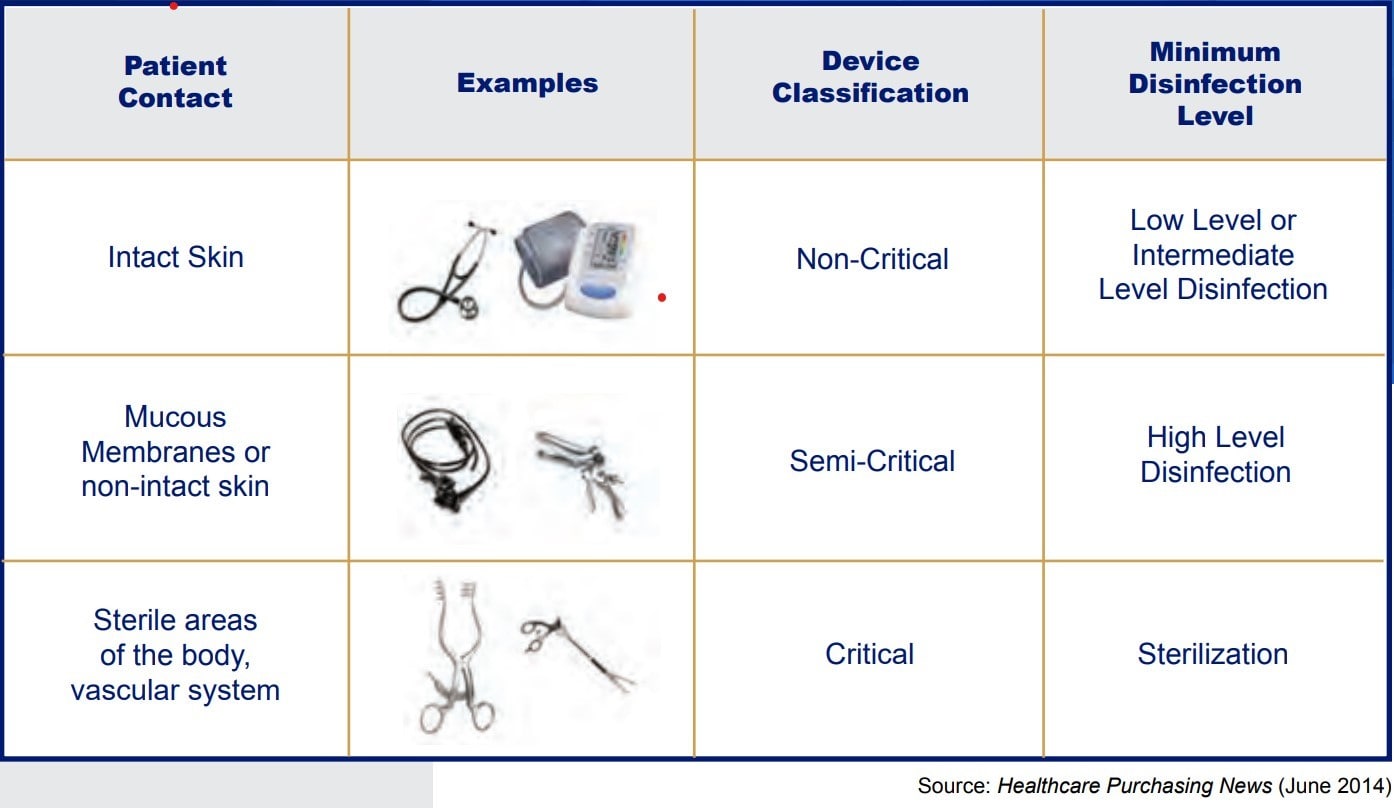 A frequently asked question on mock surveys is, “How do I know what type of cleaning and disinfection process is needed for my ultrasound transducers (probes)?”
A frequently asked question on mock surveys is, “How do I know what type of cleaning and disinfection process is needed for my ultrasound transducers (probes)?”
The use of diagnostic ultrasound imaging continues to expand beyond the conventional settings of radiology,
cardiology, and obstetrics. Today, point-of-care ultrasound (POCUS) is widely utilized at the bedside throughout hospitals, as well as in physician offices and ambulatory care locations. Users of ultrasound need to be familiar with, and utilize, the appropriate methods to clean and reprocess transducers between exams to comply with clinical guidelines and to avoid placing patients and users at risk for cross-contamination. It is essential that users reference the manufacturers’ information for use (IFU) to avoid damaging the transducers as well as ensuring the highest level of cleanliness.
More than 30 years ago, Earle H. Spaulding devised a rational approach to disinfection and sterilization of patient-care items and equipment. This classification scheme is so clear and logical that it has been retained, refined, and successfully used by infection control professionals and others when planning methods for disinfection or sterilization. Spaulding believed the nature of disinfection could be understood readily if instruments and items for patient care were categorized as critical, semi-critical, and non-critical according to the degree of risk for infection involved in use of the items.
SPAULDING CLASSIFICATION GRID
This is how the Spaulding Classification applies to Ultrasound Transducers.
• Non-critical—Applies to transducers that come in contact only with intact skin. These are sometimes referred to as external transducers. Examples include transducers used for abdominal, cardiac, obstetric, vascular, and small parts applications when the patient's skin is intact in the region of examination.
• Semi-critical—Applies to transducers that come in contact with internal mucosal surfaces such as the vagina, esophagus, or rectal vault, and any probe that is used to scan patients who have open wounds. Examples include transducers used for endovaginal (EV) obstetrics and gynecology, transesophageal echocardiography (TEE), and endorectal (ER) prostate applications, as well as external probes used to scan patients who have open wounds in the region of examination.
• Critical—Applies to transducers used in sterile body cavities. Examples include intraoperative hockey-stick style, laparoscopic, and intravascular ultrasound (IVUS) transducers. Transducers and needle guides used for interventional procedures are also considered critical devices because they may come in contact with needles and other instruments that penetrate sterile tissue.
Adequate transducer preparation is mandatory to protect patients from potential infection. The level of preparation depends on the type of examination performed. Preparation of external transducers between patients requires a low-level disinfection (LLD) process. Preparation of internal transducers between patients requires routine mandatory high-level disinfection (HLD), and the use of a high-quality single-use transducer cover during each examination. Users should consult transducer manufacturer’s instructions for disinfecting devices. Barriers used for internal and interventional percutaneous procedures must be single-use transducer covers that meet the sterility requirements of the procedure. For all chemical disinfectants, precautions must be taken to protect workers and patients from the toxicity of the disinfectant. Have your disinfection processes been recently reviewed and updated?
Sterile single-use transducer gel packets should be used when infection is a concern. If cross-contamination is a concern, non-sterile single-use gel packets should be used. For all other situations, multidose containers may be used. Dry heat should be used to heat gel where medically needed. Low level disinfection cleaning of equipment is a significant part of interrupting the cross-contamination chain. (AIUM 2020)
An alternative to manual disinfection is the automated ultrasound transducer re-processors. These are closed systems for HLD that offer several advantages over manual disinfection methods. Such devices reduce the risks of operator error and can improve patient and operator safety by preventing exposure to toxic chemicals. These devices can be used in many settings where POCUS is practiced, such as an emergency department or private physician office. These devices have intrinsic safety mechanisms built into the hardware and software operating systems that create forcing functions to ensure key steps in the process occur and prevent the equipment from operating if the key steps are not completed. Consider where a manual vs. automated process would be more suitable.
Transducers should be stored in a clean environment between uses to protect them from damage or contamination. The storage method should comply with manufacturers' recommendations. (ECRI 2018)
The guidelines below define out the type of transducer and what disinfection process should be utilized.
GUIDELINES FOR CLEANING AND PREPARING ULTRASOUND TRANSDUCERS (AIUM 3/27/2020)
No matter what type of ultrasound transducer you are using it is important to remember to reference the manufacturers’ information for use to avoid damaging your equipment.
REFERENCES
Guidelines for Cleaning and Preparing External- and Internal-Use Ultrasound Transducers and Equipment Between Patients as well as Safe Handling and Use of Ultrasound Coupling Gel, American Institute of Ultrasound in Medicine (AIUM), 3/27/2020.
Cleaning and Disinfecting Diagnostic Ultrasound Transducers: Our Recommendations, ECRI, 2020.

